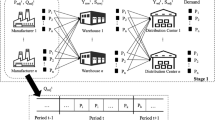Abstract
The increasing variety of products offered by the food industry has helped the industry to respond to market trends, but at the same time has resulted in a more complex production process, which requires flexibility and an efficient coordination of existing resources. Especially in industrial yogurt production, there is a wide variety of products that differ in features like fat content, the whey used to produce the mixture, the flavor, the size of the container or the language on the label. The great diversification and the special features that characterize yogurt production lines (satisfaction of multiple due dates, variable processing times, sequence-dependent setup times and costs and monitoring of inventory levels), render generic scheduling methodologies impractical for real-world applications. In this work we present a customized Mixed Integer Linear Programming (MILP) model for optimizing yogurt packaging lines that consist of multiple parallel machines. The model is characterized by parsimony in the utilization of binary variables and necessitates the use of only a small pre-determined number of time periods. The efficiency of the proposed model is illustrated through its application to the yogurt production plant of a leading dairy product manufacturing company in Greece.
Similar content being viewed by others
References
Allahverdi, A., Gupta, J. N. D., & Aldowaisan, T. (1999). A review of scheduling research involving setup considerations. Omega, 27(2), 219–239.
Bureau, G., & Multon, J.-L. (1996). Food packaging technology. New York: Wiley-VCH.
Chen, C., Liu, C., Feng, X., & Shao, H. (2002). Optimal short-term scheduling of multiproduct single-stage batch plants with parallel lines. Industrial Engineering & Chemistry Research, 41, 1249–1260.
Giannelos, N. F., & Georgiadis, M. C. (2003). Efficient scheduling of consumer goods manufacturing processes in the continuous time domain. Computers & Operations Research, 30(9), 1367–1381.
Gupta, S., & Karimi, I. A. (2003). An improved MILP formulation for sheduling multiproduct, multistage batch plants. Industrial Engineering & Chemistry Research, 42, 2365–2380.
Janak, S. L., Lin, X., & Floudas, C. A. (2004). Enhanced continuous-time unit-specific event-based formulation for short-term scheduling of multipurpose batch processes: Resource constraints and mixed storage policies. Industrial Engineering & Chemistry Research, 43(10), 2516–2533.
Kang, S., Malik, K., & Thomas, L. J. (1999). Lotsizing and scheduling on parallel machines with sequence-dependent setup costs. Management Science, 45(2), 273–289.
Karimi, I. A., & McDonald, C. M. (1997). Planning and scheduling of parallel semicontinuous processes. 2. Short-term scheduling. Industrial Engineering & Chemistry Research, 36(7), 2701–2714.
Kessler, H. G. (1981). Food engineering and dairy technology. Munich: Kessler.
Lamba, N., & Karimi, I. A. (2002). Scheduling parallel production lines with resource constraints. 1. Model formulation. Industrial Engineering & Chemistry Research, 41, 779–789.
Lim, M.-F., & Karimi, I. A. (2003). Resource-constrained scheduling of parallel production lines using asynchronous slots. Industrial Engineering & Chemistry Research, 42(26), 6832–6842.
McKay, K., Pinedo, M., & Webster, S. (2002). Practice-focused research issues for scheduling systems. Production and Operations Management, 11(2), 249–258.
Pinto, J. M., & Grossmann, I. E. (1998). Assignment and sequencing models for the scheduling of process systems. Annals of Operations Research, 81, 433–466.
Tahmassebi, T. (1996). Industrial experience with a mathematical-programming based system for factory systems planning/ scheduling. Computers & Chemical Engineering, 20(2), 1565–1570.
Varnam, A. H., & Sutherland, J. P. (1994). Milk and milk products: Technology, chemistry and microbiology. London: Chapman & Hall.
Author information
Authors and Affiliations
Corresponding author
Rights and permissions
About this article
Cite this article
Doganis, P., Sarimveis, H. Optimal production scheduling for the dairy industry. Ann Oper Res 159, 315–331 (2008). https://doi.org/10.1007/s10479-007-0285-y
Published:
Issue Date:
DOI: https://doi.org/10.1007/s10479-007-0285-y




